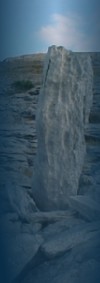

|

Corcomroe Abbey
(Corco Mraud - people of Mraud)
Between Bealaclugga and Carran,  the Abbey was established by Donal Mor
O'Brien in 1180. The remains include an altar-tomb, said to be the burial
place of King Conor O'Brien, (d.1267). It has a primitive effigy of the king. the Abbey was established by Donal Mor
O'Brien in 1180. The remains include an altar-tomb, said to be the burial
place of King Conor O'Brien, (d.1267). It has a primitive effigy of the king.
Oghtmama
This cluster of early Christian churches is located on the northern slope of
Turlough Hill. The Three churches are said to have been founded by "The Three
Colmans", (one might have been St. Colman of Kilmacduagh in Galway),
The largest, at the western side, has pre-Romanesque nave and Romanesque Chancel.
In the southwest corner there is a font carved to represent two animals with intertwined necks.
On the summit of Turlough Hill a vast Iron Age hill fort has been discovered.
Killinaboy
(Cill Inghine Bhaoth - Church of Baoth's daughter)
An early monastic site named after St. Inghean Bhaoth. It has the remains of
a church dated from the 11th or 12th century. There is a  sheila-na-gig,
over the south door. There is also the base of a round tower. sheila-na-gig,
over the south door. There is also the base of a round tower.
De Clare's House, a turret and bawn is but a short distance away on the
banks of the River Fergus.
1.5 km west is the site of the Tau Cross, a T-shaped cross with two carved
human masks one at each end of the transom. The cross has now been removed
but reproductions of the cross can be seen in the Burren Display Centre and
at the Clare Heritage Centre in Corofin.
Leamaneh Castle
(Léim an Eich or Fheidh - Leap of the horse or deer)
Between Killinaboy and Kilfenora, is one of the principal O'Brien strongholds, and
figures highly in the history of Clare  and the O'Brien fortunes. The father of Sir
Donat O'Brien built the tower-house or castle at the east end in 1480. The adjoining
house, a striking 17th century four-storey was built by Conor O'Brien, (husband of
the famous Maura Rua MacMahon), about 1640. and the O'Brien fortunes. The father of Sir
Donat O'Brien built the tower-house or castle at the east end in 1480. The adjoining
house, a striking 17th century four-storey was built by Conor O'Brien, (husband of
the famous Maura Rua MacMahon), about 1640.
An ornamental gateway dated 1643, together with a stone fireplace, were removed to
Dromoland, the main O'Brien residence, during the 19th century.
Carran
(An Carn the cairn or mound)
The village of Carran lies to the east of Slieve Carran, the highest point in this
part of the Burren. A climb to the top will be rewarded with marvellous views of this unique landscape.
Carran church: a sort distance away, are the remains of a fairly large medieval parish church.
Nearby is Temple Cronan church, (12th century), with some grotesque Romanesque heads
on the exterior wall.
 The village was the birthplace of Michael Cusack, inspirer and
co-founder in 1884 of the Gaelic Athletic Association (G.A.A,).
The village was the birthplace of Michael Cusack, inspirer and
co-founder in 1884 of the Gaelic Athletic Association (G.A.A,).
Cathercommaun fort
one of the most elaborate stone built structures
on the Burren, is situated on a cliff edge. It has three ring walls,
traces of stone houses and a souterrain or underground passage.
Cahercommaun was excavated in 1934 by Harvard archaeologists.
The structure dates from the 9th century.
Parknabinnia
Towards Killinaboy, are the megalithic tombs of Parknabinnia. The largest
is a wedge shaped gallery grave in the remains of a cairn. A number more
gallery tombs lie near by.
Corofin
(Coradh Finne - Finne's weir)
This angler's paradise lies to the southeast  of Lake Inchiquin.
The Clare Heritage Centre: offers an insightive portrayal of Irish life in
the traumatic period between 1800 and 1860. of Lake Inchiquin.
The Clare Heritage Centre: offers an insightive portrayal of Irish life in
the traumatic period between 1800 and 1860.
The two castles on Lake Inchiquin were O'Brien strongholds.
(Both are unfortunately now in ruin.)
Corofin is right at the heart of a lake complex,  which forms part of the Fergus
headwaters and offers excellent coarse and game fishing. which forms part of the Fergus
headwaters and offers excellent coarse and game fishing.
Corofin House was the birthplace of Sir Frederick Burton (1816-1900), painter and
director of the National Gallery, London.
|
|

















|

